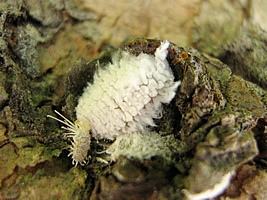Small insects belonging to the superfamily Coccoidea are known as scale insects and mealybugs. They have a quite distinct appearance from other insects and are of great importance due to the significant agricultural losses they cause. However, while many scale insects are considered pests, some species are notable for their production of varnish (Llaveia axin), shellac (Laccifer lacca), wax (Ceroplastes ceriferus), medicines (Ceroplastes ceriferus), and carmine dye (Dactylopius coccus). Many also produce a sweet secretion which, when collected and processed by bees (Apis mellifera), constitutes honeydew, a highly valuable and special honey.
Scale insect species can look very different from each other. They may be cottony, white in color with a powdery appearance (mealybugs), or waxy, with varied colors such as orange, red, green, brown, pearlescent, gray, etc (scale insects). Their forms are also diverse, resembling nail heads, oyster shells, small balls, scales, etc. The waxy scale insects, like Ceroplastes ceriferus, have a protective wax layer making them resemble small wax sculptures on plants.
The life cycle of scale insects varies among species but generally includes several stages – egg, nymph, and adult – with specific durations that can be influenced by environmental conditions such as temperature and humidity. During their life cycle, the nymphs are the most mobile stage. They seek new areas to feed, increasing the spread of the pest. Understanding this stage is crucial for effective control strategies.
The adult females are the actual pests. They are immobile and have a well-developed sucking mouthpart, capable of extracting sap directly from the plants’ vascular system. Once fixed, they produce wax, forming a shell covering their body like a shield, which protects them against natural enemies and insecticides.
Adult males are very different from females and have a short lifespan, lasting about 2 days. They never feed, have wings, tail filaments, and resemble small mosquitoes or flies. Scale insects can reproduce sexually and through seven different types of parthenogenesis, depending on the species.
Adult females lay eggs that hatch into nymphs, which are mobile, with legs and antennae. Thus, young nymphs can move, seeking a good place to settle. After the first molt, their legs atrophy, and they become immobile, continuously sucking the plant’s sap. Young males are like young females, but in the final stage, they develop wings.
Scale insects or mealybugs can be found on branches, leaves, fruits, and roots of various plants. Many have associations with ants, which protect them in exchange for the sweet secretion they produce. This secretion also promotes the growth of sooty mold (Meliola sp and Capnodium sp), fungi with dark mycelium that covers plant parts, preventing photosynthesis.
By sucking the sap of plants, scale insects can also transmit phytopathogenic viruses, contributing to the spread of diseases among plants. This highlights the importance of effective control of these pests in collections, nurseries, and gardens.
Scale insects and Mealybugs are difficult to control with insecticides, especially those with a thick shell. The shell prevents the product from contacting the insect’s body, thus the insecticide only affects the nymph stages and males. However, control with sprays of soap emulsions and mineral oil is effective, as it results in an impermeable layer over the insect, preventing it from breathing, thus killing it by suffocation. Combinations with tobacco water can also assist in eliminating the pest. It’s important to note that the use of systemic insecticides can be more effective against scale insects, as they are absorbed by the plants and reach the insects that feed on their sap.
Biological control is very important in management and is carried out by ladybugs and some species of wasps. These insects act by preying on scale insects and other pests like aphids. Therefore, the use of insecticides on affected plants should be avoided as much as possible, as we might be killing important predators and other beneficial insects, such as pollinating bees, without affecting more resistant scale insects.
In addition to biological and chemical control, cultural management practices, such as manual removal of scale insects and pruning of infested plant parts, can be effective. These practices, when combined, form an integrated pest management approach, minimizing environmental impact. Likewise, preventive practices, such as regular monitoring of plants, selection of resistant species, and maintenance of soil nutritional balance (including fertilization with calcium, potassium, and silicon), can significantly reduce the incidence of scale insects and other pests.


